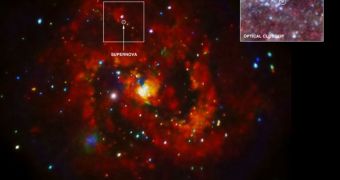Astronomers report the discovery of a new object inside the interesting supernova remnant SN 1957D. Using the NASA Chandra X-ray Observatory, a team gathered data suggesting that a very young pulsar – perhaps the youngest known to date – resides within the stellar remnant.
Supernova remnants are cosmic structures left behind after a massive star explodes. This happens when the object reaches the end of its burning cycle, and exhausts its hydrogen fuel. The resulting imbalances blow up the star.
Under special circumstances, the cores of the stars can collapse into other structures, such as neutron stars or black holes. The resulting object primarily depends on the mass of the original star.
Some 55 years ago, astronomers found a supernova event in the nearby spiral galaxy M83, which is located just 15 million light-years from Earth. The object released radiations in radio and optical wavelengths, which became visible over the ensuing decades.
Chandra itself surveyed the cosmic formation, both in 2000 and 2001, and found no signs of higher-energy radiations from the remnant. The observation session lasted for 14 hours. The latest studies conducted with the telescope totaled 8 days and 12 hours.
Following the second round of investigations (in 2010 and 2011), the observatory was able to detect X-ray radiations being produced by SN 1957D. Astrophysicists interpret the presence of such energetic light as suggesting the existence of a pulsar inside the supernova remnant.
A pulsar is a special type of neutron star, which is defined by the way we perceive the repeating flashes of radiations they emit. Neutron stars are classified as pulsars if the jets they release point at Earth periodically, resembling a lighthouse.
The pulsar inside SN 1957D may be producing what is known as a pulsar wind nebula, which is a cocoon of highly charged particles that are accelerated close to the speed of light. Scientists are currently trying to figure out if this interpretation of the available data is the correct one.
If so, then Chandra has discovered one of the youngest pulsars ever, seen at the tender age of 55. The closest contender for this object is the supernova remnant SN 1979C, which is located in the galaxy M100. However, astronomers aren't yet sure that the object at the core of SN 1979C is not a black hole.
According to the research team behind the work, which included scientists from the Space Telescope Science Institute, the Johns Hopkins University, the Curtain University, and the Harvard-Smithsonian Center for Astrophysics (CfA), details of the work will appear in the esteemed Astrophysical Journal.

 14 DAY TRIAL //
14 DAY TRIAL //